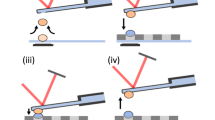Abstract
Sex-specific agglutinins from the cell surface of haploid cells of Saccharomyces cerevisiae (X2180, mta and mtα) were purified and analysed. The constitutive agglutinin from mta cells was extractable with 3 mM dithiothreitol. It was shown to be a glycoprotein (3% mannose) with an apparent Mr of 43,000 based on gel filtration, but in SDS-PAGE it behaved as a much smaller molecule (Mr between 18,000 and 26,000). About one in three amino acids was a hydroxyamino acid. Its biological activity was resistant to boiling for 1 h, but sensitive to pronase. Intact mtα cells retained their agglutinability in the presence of dithiothreitol but limited trypsinizing released a biologically active agglutinin fragment. It had an apparent Mr of 320,000 (gel filtration). When analysed by SDS-PAGE, a single diffuse band with an apparent Mr of 225,000 was observed. The protein was 94% (w/w) mannose with a trace of N-acetyl glucosamine. Its biological activity was almost completely lost after boiling for 1 h. Both agglutinins behaved as monovalent molecules and specifically inhibited the biological activity of both noninduced and pheromone-induced cells. Pheromone treatment of mta cells resulted in an apparent 32-fold increase in agglutinin activity at the cell surface, whereas pheromone treatment of mtα cells only doubled the apparent agglutinin activity.
Similar content being viewed by others
Abbreviations
- mt:
-
mating type
- DTT:
-
dithiothreitol
- SDS-PAGE:
-
sodium dodecyl sulphate polyacrylamide gel electrophoresis
- YPG:
-
yeast-peptone-glucose
- PAS:
-
periodic-acid-Schiff reagent
References
Ballou CE, Pierce M (1986) Cell recognition and adhesion in yeast mating. In: Chadwick CM, Garrod DR (eds) Hormones, receptors and cellular interactions in plants. Cambridge University Press, Cambridge, pp 241–253
Bradford MM (1976) A rapid and sensitive method for the quantitation of microgram quantities of protein utilizing the principle of protein-dye binding. Anal Biochem 72:248–254
Creighton TE (1983) Proteins: structures and molecular properties. Freeman and Company, New York
Elder JH, Alexander S (1982) Endo-β-N-acetylglucosaminidase F: endoglycosidase from Falvobacterium mengosepticum that cleaves both high-mannose and complex glycoproteins. Proc Natl Acad Sci USA 79:4540–4544
Fehrenbacher G, Perry K, Thorner J (1978) Cell-cell recognition in Saccharomyces cerevisiae. Regulation of mating-specific adhesion. J Bacteriol 134:893–901
Finkelstein DB, Strausberg S (1979) Metabolism of α-factor by a-mating type cells of Saccharomyces cerevisiae. J Biol Chem 254:796–803
Mendonca-Previato L, Burke D, Ballou CE (1982) Sexual agglutination factors from the yeast Pichia methionina. J Cell Biochem 19:171–178
Morrissey JH (1981) Silver stain for proteins in polyacrylamide gels: a modified procedure with enhanced uniform sensitivity. Anal Biochem 117:307–310
Orlean P, Ammer A, Watzele M, Tanner W (1986) Synthesis of an O-glycosylated cell surface protein induced in yeast by α-factor. Proc Natl Acad Sci USA 83:6263–6266
Pierce M, Ballou CE (1983) Cell-cell recognition in yeast. Characterization of the sexual agglutination factor from Saccharomyces kluyveri. J Biol Chem 258:3576–3582
Sakai K, Yanagishima N (1972) Mating reaction in Saccharomyces cerevisiae. II. Hormonal regulation of agglutinability of a-type cells. Arch Mikrobiol 84:191–198
Samson MR, Klis FM, Homan WL, Van Egmond P, Musgrave A, Van Den Ende H (1987) Composition and properties of the sexual agglutinins of the flagellated green alga Chlamydomonas eugametos. Planta: 170:314–321
Scopes R (1982) Protein purification. Principles and practice. Springer, Berlin Heidelberg New York
Smith PK, Krohn TI, Hermanson GT, Mallia AK, Gartner FH, Provenzano MD, Fujimoto EK, Goeke NM, Olson BJ, Klenk DC (1985) Measurement of protein using bicinchoninic acid. Anal Biochem 150:76–85
Strazdis JR, MacKay VL (1982) Reproducible and rapid methods for the isolation and assay of a-factor, a yeast mating hormone. J Bacteriol 152:1153–1161
Terrance K, Lipke PN (1981) Sexual agglutination in Saccharomyces cerevisiae. J Bacteriol 148:889–896
Thorner J (1981) Pheromonal regulation of development in Saccharomyces cerevisiae. In: Strathern JN, Jones EW, Broach JR (eds) The molecular biology of the yeast Saccharomyces cerevisiae. Cold Spring Harbor Lab, Cold Spring Harbor New York, pp 143–180
Yen PH, Ballou CE (1973) Composition of a specific intercellular agglutination factor. J Biol Chem 248:8316–8318
Zaccharius RM, Zell TE, Morrison JM, Woodlock JJ (1969) Glycoprotein staining following electrophoresis on acrylamide gels. Anal Biochem 30:148–152
Author information
Authors and Affiliations
Rights and permissions
About this article
Cite this article
Sijmons, P.C., Nederbragt, A.J.A., Klis, F.M. et al. Isolation and composition of the constitutive agglutinins from haploid Saccharomyces cerevisiae cells. Arch. Microbiol. 148, 208–212 (1987). https://doi.org/10.1007/BF00414813
Received:
Accepted:
Issue Date:
DOI: https://doi.org/10.1007/BF00414813




